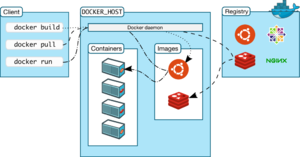Difference between revisions of "Docker"
(resize videos) |
|||
| Line 8: | Line 8: | ||
{{#ev:youtube|Qw9zlE3t8Ko|480|right}} | {{#ev:youtube|Qw9zlE3t8Ko|480|right}} | ||
| − | * https://docs.docker.com/develop/ | + | *https://docs.docker.com/develop/ |
| − | * https://docs.docker.com/engine/install/ | + | *https://docs.docker.com/engine/install/ |
| − | == Docker Images == | + | == Volumes and Mounts == |
| + | From [https://docs.docker.com/storage/ Data management in Docker]<blockquote>By default all files created inside a container are stored on a writable container layer. This means that: | ||
| + | |||
| + | The data doesn’t persist when that container no longer exists, and it can be difficult to get the data out of the container if another process needs it. | ||
| + | |||
| + | A container’s writable layer is tightly coupled to the host machine where the container is running. You can’t easily move the data somewhere else. | ||
| + | |||
| + | Writing into a container’s writable layer requires a storage driver to manage the filesystem. The storage driver provides a union filesystem, using the Linux kernel. This extra abstraction reduces performance as compared to using data volumes, which write directly to the host filesystem. | ||
| + | |||
| + | Docker has two options for containers to store files on the host machine, so that the files are persisted even after the container stops: volumes, and bind mounts. | ||
| + | |||
| + | Docker also supports containers storing files in-memory on the host machine. Such files are not persisted. If you’re running Docker on Linux, tmpfs mount is used to store files in the host’s system memory. If you’re running Docker on Windows, named pipe is used to store files in the host’s system memory.</blockquote><br /> | ||
| + | |||
| + | That is all you need to know about Docker when it comes to sharing files between the host and the container. | ||
| + | |||
| + | |||
| + | ==Docker Images== | ||
Bitnami has a [https://github.com/bitnami/bitnami-docker-mediawiki Docker Image for MediaWiki] | Bitnami has a [https://github.com/bitnami/bitnami-docker-mediawiki Docker Image for MediaWiki] | ||
Revision as of 08:43, 21 March 2023
Linux containers (LXC)[1] technology has taken off with Docker https://www.docker.com/ [2][3] which was released as open source in March 2013. RedHat and others have collaborated with the corporate backer to the technology seemingly to compete with Canonical's JuJu https://juju.ubuntu.com/ and Charm technology which also is based on Linux containers. Linux containers are built into the linux kernel, and so offer a lightweight native method of virtualization compared to more traditional (heavyweight) virtualization techniques like VMWare, Vagrant, VirtualBox.
Essentially, the difference is the hypervisor and OS. Whereas containers are implemented with kernel features like namespaces, cgroups and chroots, a full VM requires a hypervisor plus an operating system in the VM. Docker runs a docker daemon on the Docker Host.
Volumes and Mounts[edit | edit source]
From Data management in Docker
By default all files created inside a container are stored on a writable container layer. This means that:
The data doesn’t persist when that container no longer exists, and it can be difficult to get the data out of the container if another process needs it.
A container’s writable layer is tightly coupled to the host machine where the container is running. You can’t easily move the data somewhere else.
Writing into a container’s writable layer requires a storage driver to manage the filesystem. The storage driver provides a union filesystem, using the Linux kernel. This extra abstraction reduces performance as compared to using data volumes, which write directly to the host filesystem.
Docker has two options for containers to store files on the host machine, so that the files are persisted even after the container stops: volumes, and bind mounts.
Docker also supports containers storing files in-memory on the host machine. Such files are not persisted. If you’re running Docker on Linux, tmpfs mount is used to store files in the host’s system memory. If you’re running Docker on Windows, named pipe is used to store files in the host’s system memory.
That is all you need to know about Docker when it comes to sharing files between the host and the container.
Docker Images[edit | edit source]
Bitnami has a Docker Image for MediaWiki
References[edit source]
- ↑ https://help.ubuntu.com/lts/serverguide/lxc.html
- ↑ See the interview on opensource.com
- ↑ more info from Wikipedia wp:Docker_(software)
